Question
Consider the functions \(f(x) = \sqrt{3}sinx + cos x\) where 0 ≤ x ≤ π and g(x) = 2x where x ∈ R.
(a) Find ( f ο g)(x).
▶️Answer/Explanation
Ans: ( f ο g)(x) = f (2x)
\(f(2x) = \sqrt{3}sin2x + cos 2x\)
(b) Solve the equation ( f ο g)(x) = 2 cos 2x where 0 ≤ x ≤ π.
▶️Answer/Explanation
Ans: \(\sqrt{3}sin2x + cos 2x = 2cos 2x\)
\(\sqrt{3}sin2x = cos 2x \)
recognizing to use tan or cot
\(tan2x = \frac{1}{\sqrt{3}} OR cot2x = \sqrt{3}\) (values may be seen in right triangle)
\(\left ( arctan\left ( \frac{1}{\sqrt{3}} \right )= \right )\frac{\pi }{6}\) (seen anywhere) (accept degrees)
\(2x = \frac{\pi }{6}, \frac{7\pi }{6}\)
\(x = \frac{\pi }{12}, \frac{7\pi }{12}\)
Question:
A function f is defined by \(f(x) = \frac{1}{x^{2}-2x-3},\) where x ∈ R, x ≠ -1, x ≠ 3 .
(a) Sketch the curve y = f (x), clearly indicating any asymptotes with their equations. State the coordinates of any local maximum or minimum points and any points of intersection with the coordinate axes.
A function g is defined by \(g(x) = \frac{1}{x^{2}-2x-3},\) where x ∈ R, x >3.
▶️Answer/Explanation
Ans: 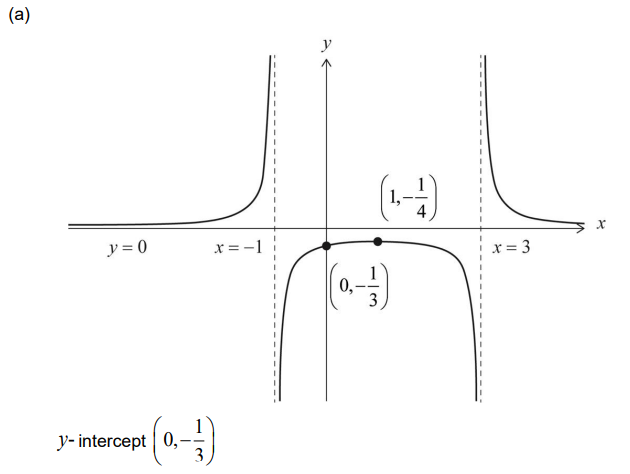
Note: Accept an indication of \(-\frac{1}{3} on the y-axis.\)
vertical asymptotes x =−1 and x = 3
horizontal asymptote y = 0
uses a valid method to find the x-coordinate of the local maximum point
Note: For example, uses the axis of symmetry or attempts to solve f’ (x) = 0 .
local maximum point \(\left ( 1,-\frac{1}{4} \right )\)
Note: Award (M1)A0 for a local maximum point at x =1 and coordinates not given.
three correct branches with correct asymptotic behaviour and the key features in approximately correct relative positions to each other
(b) The inverse of g is g-1.
(i) Show that \(g^{-1}(x)=1+\frac{\sqrt{4x^{2}+x}}{x}.\)
(ii) State the domain of g-1.
A function h is defined by h(x) = arctan \(\frac{x}{2}\), where x ∈ R.
▶️Answer/Explanation
Ans: 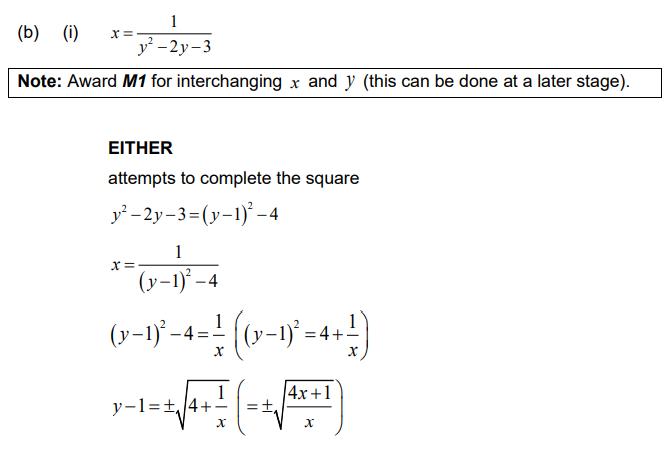
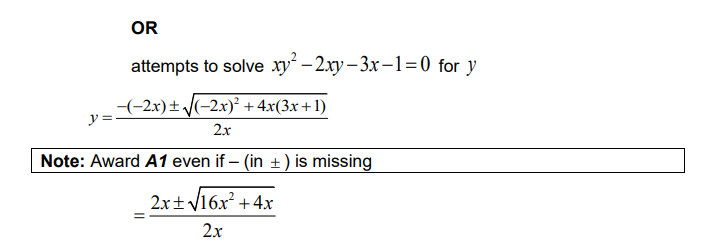
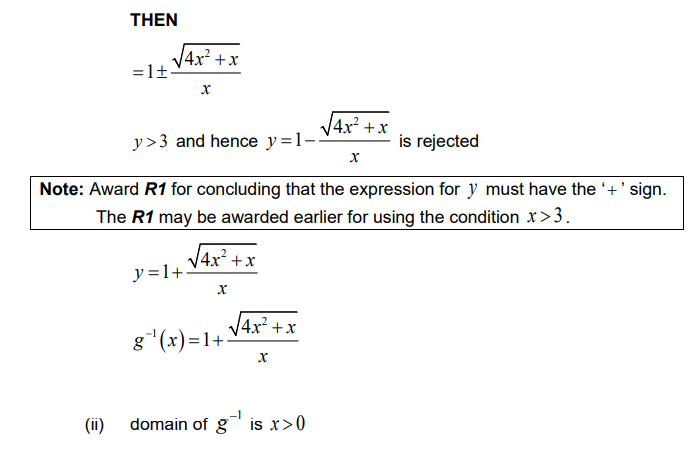
(c) Given that (h º g) (a) = \(\frac{\pi }{4},\) find the value of a.
Give your answer in the form \(p + \frac{q}{2}\sqrt{r},\) where p, q, r ∈ Z+ .
▶️Answer/Explanation
Ans: 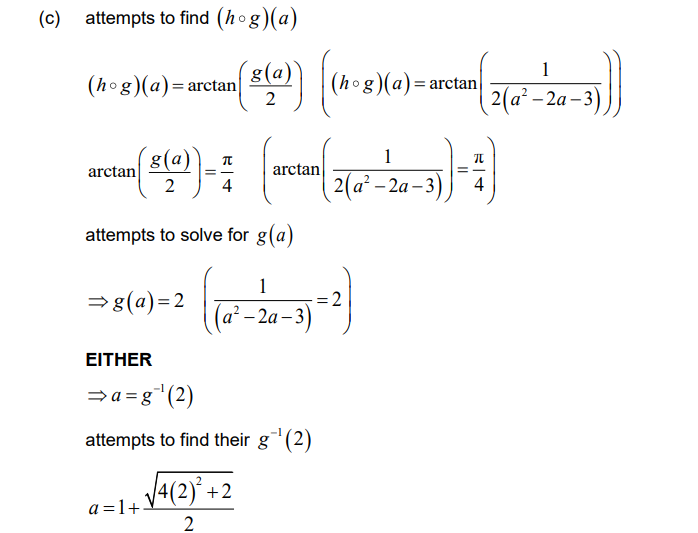
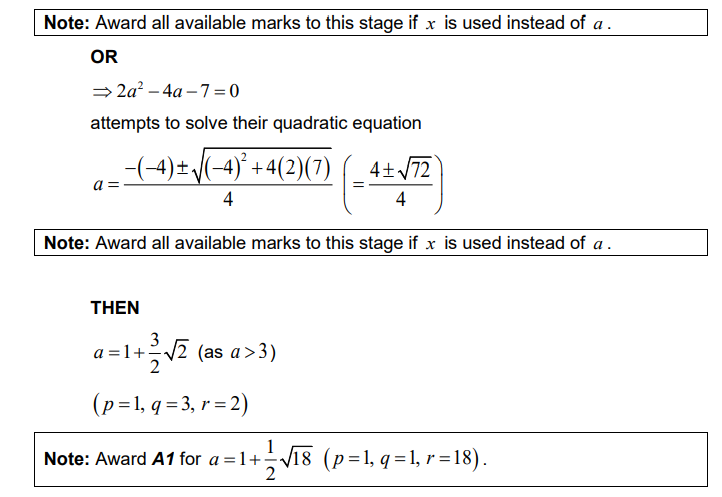
Question:
Consider the functions \(f(x) = \sqrt{3}sinx + cos x\) where 0 ≤ x ≤ π and g(x) = 2x where x ∈ R.
(a) Find ( f ο g)(x).
▶️Answer/Explanation
Ans:
(b) Solve the equation ( f ο g)(x) = 2 cos 2x where 0 ≤ x ≤ π.
▶️Answer/Explanation
Ans:
\(\sqrt{3}sin2x + cos 2x = 2cos 2x\)
\(\sqrt{3}sin2x = cos 2x \)
recognizing to use tan or cot
\(tan2x = \frac{1}{\sqrt{3}} OR cot2x = \sqrt{3}\) (values may be seen in right triangle)
\(\left ( arctan\left ( \frac{1}{\sqrt{3}} \right )= \right )\frac{\pi }{6}\) (seen anywhere) (accept degrees)
\(2x = \frac{\pi }{6}, \frac{7\pi }{6}\)
\(x = \frac{\pi }{12}, \frac{7\pi }{12}\)
Question:
The graph of y = f (x) for -4 ≤ x ≤ 6 is shown in the following diagram.
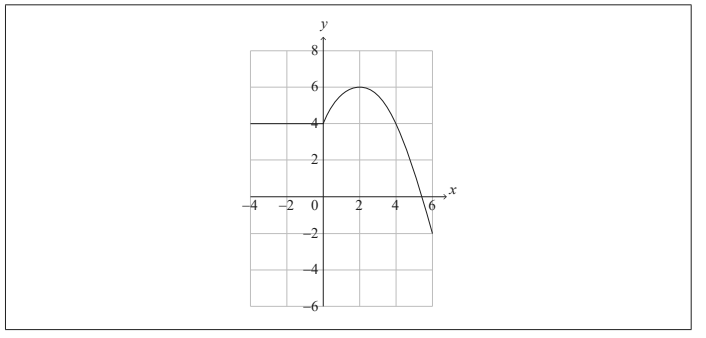
(a) Write down the value of
(i) f (2) ;
(ii) ( f o f )(2) . [2]
▶️Answer/Explanation
Ans: (i) f(2) = 6
(ii) (fof)2=− 2 [2 marks]
(b) Let g(x) = \(\frac{1}{2} f (x) +1\) for -4 ≤ x ≤ 6 . On the axes above, sketch the graph of g . [3]
▶️Answer/Explanation
Ans:
(b) 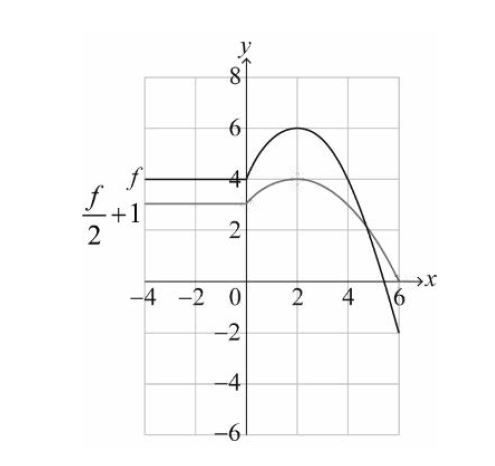
Question
The functions f and g are defined as:
\[f(x) = {{\text{e}}^{{x^2}}},{\text{ }}x \geqslant 0\]
\[g(x) = \frac{1}{{x + 3}},{\text{ }}x \ne – 3.\]
(a) Find \(h(x){\text{ where }}h(x) = g \circ f(x)\) .
▶️Answer/Explanation
Ans: \(h(x) = g \circ f(x) = \frac{1}{{{{\text{e}}^{{x^2}}} + 3}},{\text{ }}(x \geqslant 0)\) (M1)A1
▶️Answer/Explanation
Ans: \(0 < x \leqslant \frac{1}{4}\) A1A1
Note: Award A1 for limits and A1 for correct inequality signs.
▶️Answer/Explanation
Ans:
\(y = \frac{1}{{{{\text{e}}^{{x^2}}} + 3}}\)
\(y{{\text{e}}^{{x^2}}} + 3y = 1\) M1
\({{\text{e}}^{{x^2}}} = \frac{{1 – 3y}}{y}\) A1
\({x^2} = \ln \frac{{1 – 3y}}{y}\) M1
\(x = \pm \sqrt {\ln \frac{{1 – 3y}}{y}} \)
\( \Rightarrow {h^{ – 1}}(x) = \sqrt {\ln \frac{{1 – 3x}}{x}} {\text{ }}\left( { = \sqrt {\ln \left( {\frac{1}{x} – 3} \right)} } \right)\) A1
[8 marks]
Question
Let \(f(x) = \frac{4}{{x + 2}},{\text{ }}x \ne – 2{\text{ and }}g(x) = x – 1\).
If \(h = g \circ f\) , find
(a) h(x) ;
▶️Answer/Explanation
Ans: \(h(x) = g\left( {\frac{4}{{x + 2}}} \right)\) (M1)
\( = \frac{4}{{x + 2}} – 1\,\,\,\,\,\left( { = \frac{{2 – x}}{{2 + x}}} \right)\) A1
▶️Answer/Explanation
Ans: METHOD 1
\(x = \frac{4}{{y + 2}} – 1\,\,\,\,\,\)(interchanging x and y) M1
Attempting to solve for y M1
\((y + 2)(x + 1) = 4\,\,\,\,\,\left( {y + 2 = \frac{4}{{x + 1}}} \right)\) (A1)
\({h^{ – 1}}(x) = \frac{4}{{x + 1}} – 2\,\,\,\,\,(x \ne – 1)\) A1 N1
METHOD 2
\(x = \frac{{2 – y}}{{2 + y}}\,\,\,\,\,\)(interchanging x and y) M1
Attempting to solve for y M1
\(xy + y = 2 – 2x\,\,\,\,\,\left( {y(x + 1) = 2(1 – x)} \right)\) (A1)
\({h^{ – 1}}(x) = \frac{{2(1 – x)}}{{x + 1}}\,\,\,\,\,(x \ne – 1)\) A1 N1
Note: In either METHOD 1 or METHOD 2 rearranging first and interchanging afterwards is equally acceptable.
[6 marks]
Question
Shown below are the graphs of \(y = f(x)\) and \(y = g(x)\).
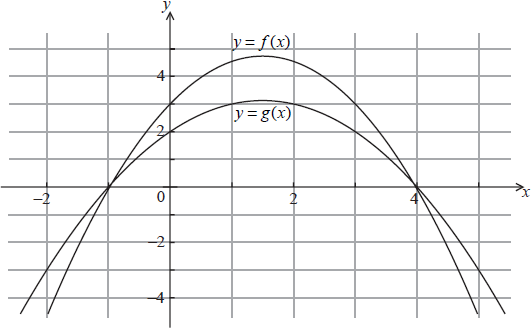
If \((f \circ g)(x) = 3\), find all possible values of x.
▶️Answer/Explanation
Markscheme
\(g(x) = 0{\text{ or 3}}\) (M1)(A1)
x = –1 or 4 or 1 or 2 A1A1
Notes: Award A1A1 for all four correct values,
A1A0 for two or three correct values,
A0A0 for less than two correct values.
Award M1 and corresponding A marks for correct attempt to find expressions for f and g.
[4 marks]
